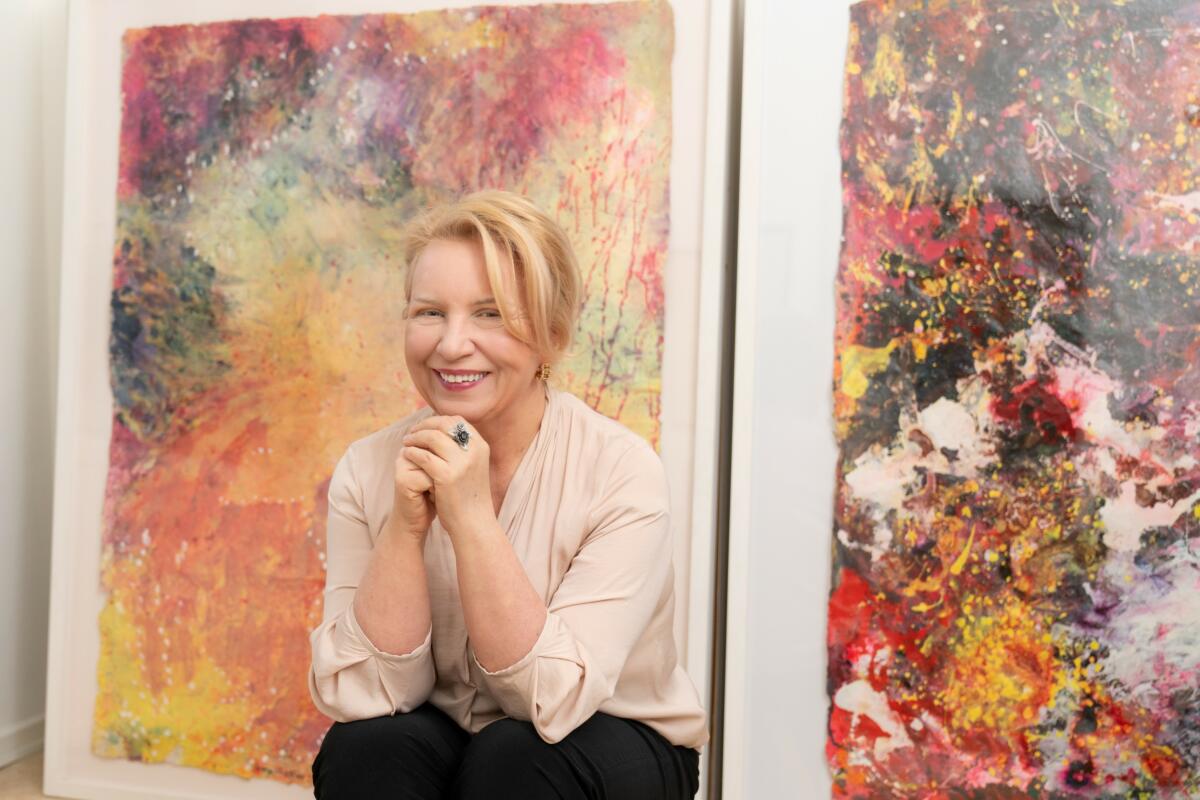Opening up new global perspectives – Christina L. Saarinen’s bequest will support fine arts students’ international activities
Visual artist and therapist Christina L. Saarinen wants to support the internationalisation of Academy of Fine Arts students with her donation. Taking physical distance to their everyday life helps students gain perspective and build their self-knowledge.

In her office, Christina L. Saarinen, who currently works as a couples and sex therapist, shows some of her works created over the years. Abstract paintings, reaching the height of a man, painted with fingers on a rag paper, with layers after layers of paint and ink. And paintings made in an instant with just a few strokes.
“For me, painting is a way of being. When I paint, that’s all I focus on. Sometimes when I wake up at night, I go and look at a painting in progress and continue working on it. This kind of concentration takes time. I haven’t had it for a while, but I’m still going to keep making art,” Saarinen says.
Many of Saarinen’s works were created abroad. She has spent a long time studying under Japanese artist Meera Hashimoto at the Osho Centre in Pune, India. Courses in meditative art and art therapy combined dancing and visual expression.
Saarinen has lived in the Middle East and travelled in the Far East and North Africa. The years spent abroad have brought inspiration and new perspectives, broadening her thinking.
Now, she wants to offer a similar opportunity to Academy of Fine Arts students by bequeathing funds to the University of the Arts Helsinki Foundation. The purpose of the fund, established in Saarinen’s name, is to support the studies and projects of the academy’s students abroad.
“Physically and mentally distancing oneself from familiar things is important. In a new environment, you see things in a different light and discover completely new sides of yourself. It is essential as an artist. It’s a good idea to go and see the world and experience yourself as part of it already at a young age,” Saarinen says.
Facing fundamental questions
For Saarinen, art is about reflecting on one’s identity and on fundamental questions. Who am I? Who are we? Where do we come from? What makes us unique? What unites us? These are some of the questions that art asks and tries to answer.
Reflection, self-exploration and self-examination ultimately generate wellbeing. Development of self-knowledge is an integral part of life. “I also think that art unites us – just like sports, for example,” Saarinen says.
When it comes to defining art, Saarinen is not restrictive at all. What matters is not what you do, but how you do it. “I think that even making food can be art and an original way of expressing yourself. When you experiment and test things out, something new is born,” she notes.
After her years abroad, Saarinen has noticed that Finns value art in a completely different way than they did some decades ago. Instead of posters, a teacher couple today may hang unique art on their walls at home. There are more art galleries than before, and they are bustling at that.
She finds that art has become more democratic within the last few decades. High culture is no longer just the culture of the elite, as it is closer to common people than before.
That is why in Saarinen’s opinion, the recent cuts in the cultural and arts sector are not the whole truth. In society, there are simultaneous trends, all going in different directions.
Years abroad have also opened Saarinen’s eyes to the fact that the art being created in Finland is excellent even on a global scale. “We have fewer patrons of arts and less public funds than many other countries, but our art is still of high standard,” she says.
Young people are the future of art
Saarinen knows from her own experience that making art takes time.
“Creating something new is a process. Even if the actual work doesn’t take very long, it is often preceded by long preparations, brainwork and reflection,” Saarinen notes.
She finds that young artists, in particular, should receive support. They must be given the time and the environment that they need for making art.
“Visual arts may not necessarily be the first thing people give their support to. It has been a somewhat neglected receiver of donations. And art students, especially, are sidelined. Often, they can only dream of getting grants. Financial support usually goes to experienced artists,” Saarinen says.
Still, young people are the future of Finnish art. They need space to grow.
More information about Christina L. Saarinen´s art is available on her website christinasaarinen.com
Text: Anu Vallinkoski